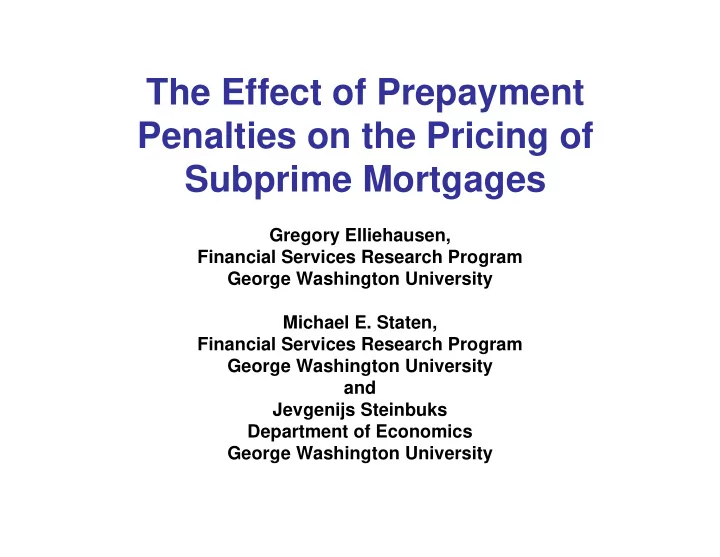

The Effect of Prepayment Penalties on the Pricing of Subprime Mortgages Gregory Elliehausen, Financial Services Research Program George Washington University Michael E. Staten, Financial Services Research Program George Washington University and Jevgenijs Steinbuks Department of Economics George Washington University
Policy Issue • Subprime borrowers prepay at a significantly higher rate than prime borrowers. • Prepayment penalties offset some of the risk of prepayment by encouraging borrowers to select loans based on their private information about the expected holding period and by compensating lenders in the event of prepayment. • Price sheets for subprime loans typically contain adjustments that increase the price paid on loans without a prepayment penalty or with relatively short prepayment penalty periods. • Some advocacy groups have questioned whether borrowers actually receive a lower loan price in exchange for accepting a prepayment penalty. • They attribute subprime borrowers’ inability to obtain a lower loan price to information problems, inexperience, lack of bargaining skills, or failure to shop.
Previous Studies • DeMong and Burroughs (2005) – Data on 30-year first mortgages originated by several large national subprime lenders during 2004. – Prepayment penalty was associated with lower annual percentage rate. – Other explanatory variables were the FICO risk score, the borrower’s income, the loan to value, and whether or not reduced documentation requirements. • Ernst (2005) – Data on securitized 30-year first mortgages originated 2000- 2002. – Prepayment penalty was not associated with lower interest rate. – Other explanatory variables were loan to value, FICO risk score, the borrower’s debt-to-income ratio, whether or not income was fully documented, property type, whether or not a jumbo loan, the proportion of the population in the ZIP code area that is minority (non-whites), dummy variables for month of origination.
This Study • We use the Financial Services Research Program’s subprime mortgage origination database. • The database contains information on all originations since Q3 1995 of eight subprime mortgage subsidiaries of large financial institutions. • The data allow us to replicate previous studies. • We estimate separate models for fixed-rate, variable-rate, and hybrid first mortgages with a 30-year term to maturity.
Determinants of Loan Price (measured by risk premium) • Loan terms – Loan to value – Whether or not loan has prepayment penalty – Whether or not loan has reduced documentation • Distribution channel – Whether or not origination through broker • Borrower risk – Whether or not the home is owner occupied – FICO score – Borrower income
Simultaneity and the Choices of Loan Terms • A potential confounding factor is that the price may be chosen simultaneously with other loan terms such as loan amount, (and therefore loan to value), and the presence of a prepayment penalty. • Lenders typically offer a number of different equity and prepayment options, with each option entailing a different interest rate. • The borrower chooses from among these options. • Consequently, interest rate, loan to value, and the prepayment penalty option are all endogenous, a condition that causes single-equation coefficients to be biased and inconsistent.
Simultaneous Equation Model • We develop a three-equation model, in which price (risk premium), loan to value, and prepayment penalty are determined simultaneously. • We estimate the model using two-stage least squares. • Instruments are one-year treasury rate (opportunity cost) in risk premium equation; borrower age and average local property value (wealth) in loan-to-value equation; and mobility, and state law dummy in prepayment penalty equation.
Selected Findings • Tests provide support for the hypothesis that risk premium, loan to value, and prepayment penalty are endogenous. • In the 2SLS models, the effects of loan to value on risk premiums are uniformly negative, consistent with expectations, and larger in absolute value than the OLS estimates. • OLS coefficients for loan to value appear to be biased toward zero.
Selected Findings (continued) • The prepayment dummy variable in the single- equation models and the predicted probability of a prepayment penalty in the 2SLS models are statistically significant and negatively related to risk premiums. • The 2SLS estimates suggest that presence of a prepayment penalty reduces risk premiums by 38 basis points for fixed-rate loans, 13 basis points for variable-rate loans, and 18 basis points for hybrid loans. • The 2SLS estimates of reductions in price are smaller than the single-equation estimates for fixed-rate and variable-rate mortgages and larger than the single- equation estimate for hybrid mortgages.
Replication of Previous Studies • DeMong and Burroughs (2005) – We estimated the same model and obtained similar results for all estimated coefficients. – The presence of a prepayment was negatively related to the annual percentage rate. • Ernst (2005) – Due to differences in databases, we were unable to estimate the exact model, but estimation of a similar model produced the same finding for prepayment penalties. – Nevertheless, we were able to replicate the key finding that the presence of prepayment penalties was associated with no difference in interest rates or higher interest rates.
Conclusions • Using a model that accounts for endogeneity of price, loan to value, and prepayment penalty, we find that prepayment penalties are associated with significantly lower prices for subprime mortgages. • It is doubtful that our results are unique to our database of subprime mortgages. • We replicate the models of two previous studies of the pricing of prepayment penalties using our database and find similar results in our study. • Mortgage choices are complex decisions involving simultaneous consideration of numerous loan terms. • Such decisions require careful modeling to avoid biases due to simultaneity and selection.
Recommend
More recommend